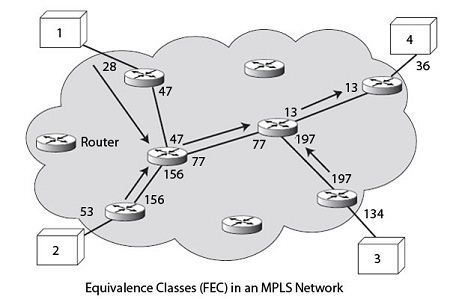LDP (Label Distribution Protocol) is the reference distribution protocol which tends to become the most used in MPLS standard. This protocol takes account of unicast and multicast addresses. Routing is explicit and is managed by the output nodes. Exchanges are carried out under the TCP to ensure acceptable quality.
Two classes of messages are accepted, that of adjacent messages and the messages indicating the references. The first to query the nodes that can be reached directly from the source node. The second class of messages transmits the reference values when there is agreement between the adjacent nodes. These messages are encoded in the traditional form, that describes an object: it is indicated in a first field the type of object in a second the total length of the message describing the purpose and in a third the value of the object . This encoding is called TLV (Type Length Value).
The routing is done, as we have seen, by equivalence classes, or FEC (Forward Equivalent Class). A class represents a destination or group of destinations with the same prefix in the IP address. Therefore, a packet that has a destination in a class and follows a common road with other packets of this class. This defines a tree, whose root is the recipient and whose leaves are the transmitters. The packages have only to follow the tree to the root, the waves superimposed gradually going towards the root. This solution does not use too many different references.
The granularity of the references, that is to say the size of the waves that use the same reference, results from the size of equivalence classes: if there is little of equivalence classes, the waves are high, and the granularity is high; if there are many equivalence classes, the waves are low, and granularity is fine. For example, a destination can correspond to a large network, in which all addresses have a common prefix. The destination can also correspond to a particular application on a given machine, which gives a high degree of granularity. The latter case is illustrated in Figure, in which the receiver is the machine 1 and the FEC is determined by the tree whose leaves are the terminal equipment 1, 2 and 3. The equivalence class, going down the tree from 1 begins with the references 28 and 47 and is continued by the branches 77 then 13 then 36. From 2, references 53 and 156 are used to go to the root. From 3, are the references 134 and 197 are used. All references just cited belong to the same equivalence class.

In this example, the terminals 1, 2 and 3 seeking to send a stream of IP packets to the terminal station 4. For this, the station 1 sends its frames (encapsulating IP packets) with the reference 28, which is switched to the reference 47 then switched to the references 77 and 13 and 36. The flow from station 2 is switched from 53 to 156 and then 77, 13 and 36. The third wave, from station 3 is switched from the values 134 then 197, 13 and 36. It is seen that aggregation is carried out on the first two waves with the single value 77 and the three streams are aggregated on the values 13 and 36. The station 4 could be replaced by a subnet, which would certainly have much to aggregate flows and have a coarser granularity.
One problem with the routing tables involving FEC is that potential loops, that is to say a possible return to a station that has already seen passing the frame.
If the routing protocol such as OSPF uses a one avoids loops using an information message.
The LDP includes the following messages:
• Message Discovery (DISCOVERY MESSAGE), and maintains that announces the presence of an LSR in the network.
• Session Message (MESSAGE SESSION) that establishes, maintains and terminates sessions between LDP ports.
• Warning Message (ADVERTISEMENT MESSAGE), which creates, maintains and destroys the correspondence between the references and the FEC.
• Notification Message (MESSAGE NOTIFICATION), which gives information error or problem.
Switching tables can be constructed and controlled in different ways. The Internet routing protocols such as OSPF, BGP, PIM, etc., are generally used for this purpose. They need to add procedures to match the references and FEC equivalence classes.
We have indicated that the distribution of references was by downstream up towards the transmitting station. In fact, it is stated in the standard MPLS that the distribution of the references can be performed by the downstream (downstream) or upstream (upstream). In the first case, the receiver indicates to the nodes upstream of the reference value to put in the switching table. In the second case, the packet arrives with a reference, and the node updates its switching table.
In the upstream distribution (upstream), a downstream node sends the value of the reference it wishes to receive for switching a packet on an FEC. These are the nodes located further downstream which initiate the process and indicate the recipients and their granularity. Changes are made upon receipt of a frame or by means of overhead information.
The distribution of the identifiers can be carried out via protocols RSVP-TE or PIM.
 Dinesh Thakur holds an B.C.A, MCDBA, MCSD certifications. Dinesh authors the hugely popular
Dinesh Thakur holds an B.C.A, MCDBA, MCSD certifications. Dinesh authors the hugely popular